A cat behavior problem refers to any undesirable, problematic, or abnormal actions by a pet cat. Behavior problems vary in severity and can have a massive negative impact on the cat’s relationship with their owner and on the animal’s well-being.
Cat behavior problems have many causes, including stress, health problems, incorrect training, poor socialization, and changes within your household. A badly behaved cat can be aggressive, excessively vocal, scratching your furniture, and relieving herself outside of her litter box, to name a few.
The types of aggression cats display generally fall into two main groups; defensive and offensive. This guide touches on aggressive cat behavior.
Fortunately, stopping/correcting bad behavior can be achieved relatively easily through clicker training, remote correction, and using sound as a deterrent.
Keep reading to learn everything you need to know about different types of cat behavior problems, what causes them, and how to manage your feline friend effectively when she starts acting out!
What Causes Behavioral Problems In Cats?
The common causes of cat behavior problems are pretty varied, and understanding why your cat does what she does is essential for addressing and managing those issues effectively.
Some common causes of behavioral problems in cats include:
Lack Of Socialization
Socializing your cat when she’s a kitten is critical. If your furry friend hasn’t been exposed to people, animals, different sights, and sounds, she might become fearful and anxious when she comes across something unfamiliar, leading to behavioral problems in adulthood.
Stress Or Anxiety
This behavior usually links to changes within your cat’s environment or regular routine that can cause your pet to become anxious or stressed.
Medical Issues
Sometimes, behavioral problems can indicate underlying medical problems. For example, when one of my cats developed diabetes, she acted out and became quite feisty, which was totally out of character for her.
So, if your cat’s behavior changes for no apparent reason, I recommend consulting your vet first to rule out any health issues.
Inadequate Environmental Enrichment
Cats are intelligent, curious creatures that become bored easily if not provided with toys, scratching posts, and the like to enrich their environment.
Improper Litter Box Management
Improper litter box management is a common behavioral problem in cats and is often caused by the cat not liking the type of litter you’ve used, the litter box’s cleanliness, or where you’ve placed the box.
Conflict With Other Cats
Cats are territorial creatures that patrol and defend their home patch, so if you bring a new pet home or have a multicat household, one cat will likely try to be dominant.
Punishment-Based Training
Using negative reinforcement or punishment to correct your cat’s unwanted behavior can cause fear and anxiety in your pet and make her behavioral problems worse.
Instead, when training your cat, always use positive reinforcement and give plenty of rewards to show your pet when she’s done the right thing.
Lack Of Play And Exercise
Although all cats are different, most enjoy playing an interactive game with their owner or taking a stroll around your backyard. If your cat is denied those things, she will become frustrated and bored and might begin behaving badly.
If you don’t want your cat to roam freely outside, why not train her to walk on a harness and leash? That way, you can enjoy more exercise and safely explore your local neighborhood together!
Sudden Changes In The Household
Cats are highly sensitive to environmental changes, so your cat’s behavior could change if you make changes in your household.
For example, when I moved home, both my cats spent the first few days hiding behind the sofa until we established a new routine, and they settled in.
Inconsistent Or Insufficient Training
When training your cat, your approach must be consistent and use the same cue words and gestures to avoid confusing your cat.
Cats thrive on a routine; if you neglect your cat’s daily training sessions, she could forget her lessons and begin behaving badly.
What Are The Most Common Cat Behavior Problems?
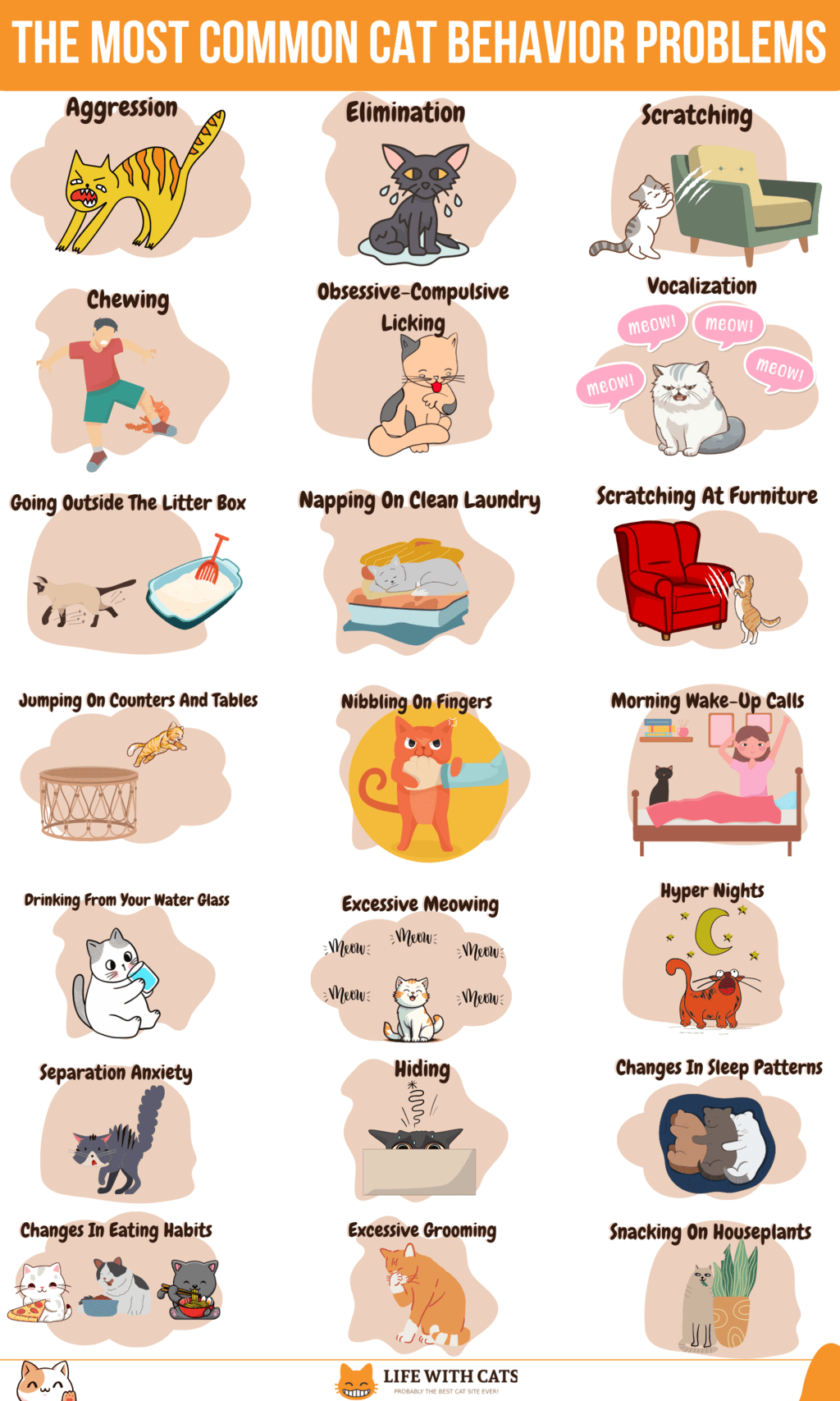
Common cat behavior problems are many and varied and can affect cats of different breeds, ages, and personalities.
Here are some of the most common cat behavior problems you could experience if your feline friend starts acting out.
Aggression
Aggression is a distressing cat behavioral problem that can be dangerous when directed toward other pets, you, or your family.
There are two primary forms of cat aggression; defensive and offensive aggression. Some cats become aggressive when defending their territory, being groomed, because of certain health conditions, and simply because they haven’t been properly socialized and are afraid.
Elimination
Sometimes, a cat will relieve itself in random places around your home. That behavior could be due to medical issues, territorial marking (typically in male cats), a dirty litter box, and stress.
Scratching
Scratching is a natural behavior that cats do to keep their claws sharp and to remove old nail material. However, scratching can be a problem when directed at your furniture or floor coverings, so you should provide your kitty with a scratch post or mat and train her to use that instead.
Chewing
Cats sometimes chew or bite during play, when overstimulated, or because of fear or aggression.
Obsessive-Compulsive Licking
Some cats lick and self-groom obsessively, despite your regular grooming and brushing sessions. That can lead to skin irritation, and the loose hair the cat ingests can cause hairballs and associated health problems.
Obsessive-compulsive licking can indicate an underlying health problem, so always consult your vet if your cat behaves this way.
Vocalization
If your cat starts meowing excessively, she could be attention-seeking, suffering from an underlying health issue, or simply hungry or thirsty.
Going Outside The Litter Box
Most cats are very clean creatures that will readily accept and use their litter box.
However, suppose your cat starts going outside her litter box. In that case, her bad behavior generally tells you that the cat doesn’t like the type of litter you’re using, the box is in an unsuitable place, or your pet has an undiagnosed medical condition.
Napping On Clean Laundry
Cats typically seek somewhere warm and dry to sleep, so if you find your cat napping on your clean laundry, don’t be surprised, especially if the laundry is kept in a warm cupboard!
There’s a simple solution to this problem: shut the cupboard door to keep your cat out or put your laundry away where the cat can’t access it!
Scratching At Furniture
As mentioned above, your cat scratches to keep her claws in good condition. To keep your furniture safe, try providing your cat with a nice scratching post or mat and take the time to train her to use it.
Snacking On Houseplants
When I got two kittens a few years ago, I had a nice array of beautiful houseplants in decorative pots around my home. Unfortunately, within a few days of the little bundles of fluff arriving, my plants were reduced to a shredded mess!
Cats are curious animals, and chewing and nibbling on things is simply their way of exploring something unfamiliar unless you grow catnip in your home. And that’s just asking for trouble!
On a serious note, many houseplant species are poisonous to pets, so always double-check that your plants are safe around your cat.
Jumping On Counters And Tables
Cats naturally seek out higher ground since that gives them a good view of the surrounding area, creating a feeling of safety and security.
Of course, if your cat is food-oriented, she might jump on counters and tables in the hope of finding a tasty snack.
Nibbling On Fingers
Cats explore their surroundings with their mouths since they don’t have hands and fingers like ours. So, it’s quite natural for your cat to sometimes nibble on your fingers, and although that can be annoying, it’s not really bad behavior on your cat’s part, as long as she doesn’t bite you, of course!
Morning Wake-Up Calls
I rarely set my alarm clock when I go to bed. How so? Well, my cat Spotty goes out at night, arriving home at 6 am and meowing outside my bungalow’s bedroom window until I let him in and feed him.
Although that’s annoying if I don’t need to get up so early, at least I won’t oversleep!
Drinking From Your Water Glass
If your cat is thirsty, she might help herself to a sip or two of water from your glass. You can easily stop that habit by ensuring your cat has a bowl of clean water available 24/7.
Excessive Meowing
Some cat breeds are more vocal than others and tend to meow constantly, which is infuriating unless you can tune out their background noise somehow.
Hyper Nights
Hyper nights or midnight crazies, as they’re also known, can be extremely irritating, especially if you’re a light sleeper. When your cat has a hyper night attack, she charges around your home in fits and starts, typically during the middle of the night.
Separation Anxiety
Cat separation anxiety is when your cat becomes extremely anxious when left alone. Signs that your cat is suffering from this behavioral disorder include:
- Excessive vocalization
- Excessive self-grooming
- Elimination outside the litter box
- Destructive behavior
- Trying to escape
Hiding
Sometimes, cats hide from their owners, largely due to stress and anxiety.
Changes In Sleep Patterns
Most cats sleep for much of the day, typically becoming more active at night. If your cat’s sleeping patterns change, I recommend you speak to your vet for advice.
I once had a senior cat who started waking and vocalizing at night, so I took her to my vet clinic. It turned out that my furry friend was suffering from the cat equivalent of dementia, which affected her sleep patterns. Luckily, drug therapy worked well to control my pet’s behavior and improve her quality of life.
Changes In Eating Habits
If your cat’s eating habits change, that could mean she doesn’t like the new brand of food you bought.
I recommend you ask your vet to examine your cat in case your pet has developed dental problems that make eating painful or has some other health condition that requires medical attention.
Excessive Grooming
Most cats are fussy about licking and grooming themselves, and they do so daily to keep their coats and skin in good condition.
Sometimes, a cat begins self-grooming excessively, which can cause problems such as hairballs and skin irritation.
Can You Stop/Correct Bad Behavior In Cats?
Yes, it is possible to stop or correct some bad behaviors in cats or at least modify them through appropriate cat behavior training.
To stop/correct bad cat behavior, you’ll need the following:
- A clicker device
- Treats
- Treat pouch
- Toys
- Calming products
Many common bad behaviors, such as scratching, aggression, and excessive vocalization, can be addressed by using the following generic process:
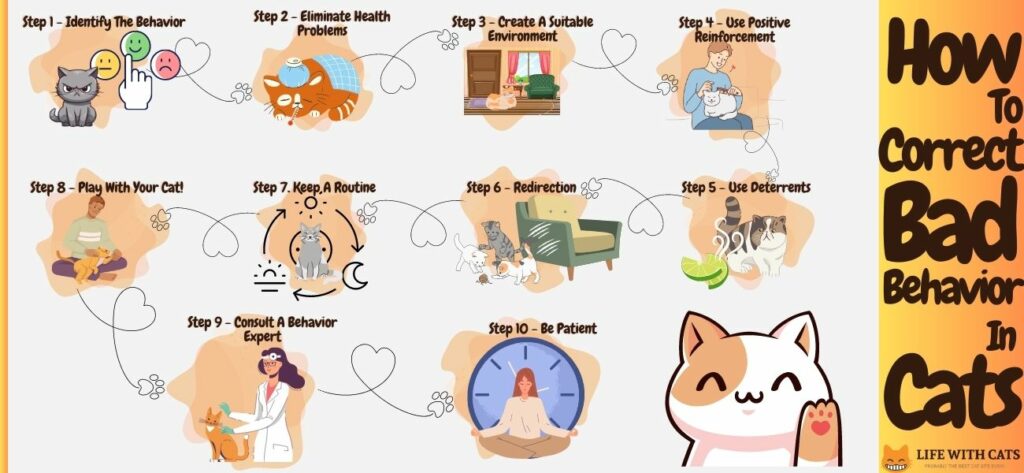
Step 1 – Identify The Behavior
First of all, you need to observe your cat to identify the specific behavior you want to address, such as aggression, inappropriate elimination, or something else.
Step 2 – Eliminate Health Problems
Some cat behavior issues are caused by underlying, undiagnosed health problems. So, before assuming that your cat is simply behaving badly, I advise you to have your pet examined by your vet to rule out any medical problems.
Step 3 – Create A Suitable Environment
An inadequate living environment causes some bad behavior, so be sure to provide your cat with plenty of hiding places, scratching posts, perches, and a clean litter box. That can help to reduce stress and prevent undesirable cat behavior.
Step 4 – Use Positive Reinforcement
Rather than punishing your cat’s behavior, focus on rewarding her for good behavior. For example, whenever your cat displays positive behavior, such as using her litter box, praising her, making a fuss of her, or offering her some high-value treats.
Many cats respond well to a clicker training program or something similar that uses an immediate reward to reinforce good behavior.
Step 5 – Use Deterrents
Sometimes, using deterrents, such as citrus-scented sprays or double-sided tape on furniture edges to prevent scratching, can prevent your cat from behaving badly.
Step 6 – Redirection
When you see your cat Behaving Badly, quickly redirect her attention to an appropriate toy or other activity. For example, if your cat is scratching your sofa, gently relocate her to a scratching mat or post, and remember to offer a suitable reward and praise.
Step 7. Keep A Routine
Most cats do best with a daily routine for feeding, playtime, socialization, and training, helping to reduce anxiety and prevent attention-seeking behavior such as excessive vocalization.
Step 8 – Play With Your Cat!
Set aside time to play with your cat using an interactive toy each day.
Playtime can provide your cat with the mental and physical stimulation she needs to reduce boredom-related bad behaviors and keep her fit too.
Step 9 – Consult A Behavior Expert
If your cat’s undesirable behavior persists or becomes, I advise you to seek advice from a certified cat behaviorist or vet with experience in behavioral issues.
Step 10 – Be Patient
Changing your cat’s behavior can take time, especially if you have an older cat that you have taken from a shelter or cat rescue center. Be patient and consistent with your training efforts, and do not be afraid to seek professional advice if you find yourself struggling to help your feline friend.
Clicker Training
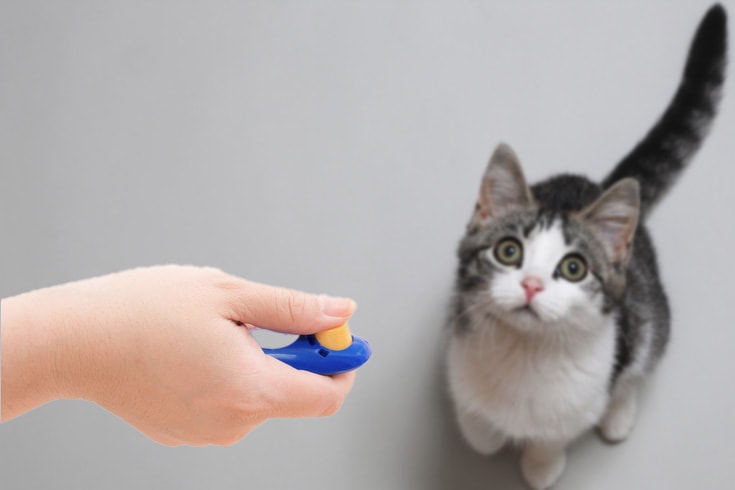
A clicker is a small handheld device that makes a clicking sound when pressed.
When clicker training cats, click the clicker immediately after your pet exhibits the behavior you want, and reward her with the treat. That way, your pet learns to associate exhibiting good behavior with a click and a tasty reward and will be more likely to repeat that behavior.
Remote Correction
Remote correction in cat training typically refers to a way of correcting your cat’s undesirable behavior from a distance without physically touching your cat or being close to her.
This form of training means that the cat won’t automatically regard you as the bad guy, and can be useful in correcting unwanted behaviors, including scratching furniture and jumping onto countertops.
Remote correction uses devices such as ultrasonic and noise-making devices.
Sound As Deterrent
Some owners use sound as a deterrent to startle their cats and distract them from their undesirable behavior.
Popular sound deterrents include making a loud hand clap or shaking a plastic bottle containing coins or beads.
Cat Behavior FAQs
Here are the answers to some of the most frequently asked questions about cat behavior problems and how to deal with them.
Why Would A Cat Suddenly Change?
Cats can exhibit sudden changes in behavior for various reasons, including the following:
- Health issues
- Stress or anxiety
- Territorial disputes
- Environmental changes
- Socialization issues
- Hormonal changes
- Boredom or lack of stimulation
- Negative reinforcement or punishment
- Aging
- Traumatic experience
If your cat suddenly changes her behavior, always ask your vet for advice, as your cat could have an undiagnosed health problem causing her to behave differently.
Does Cat Behavior Change With Age?
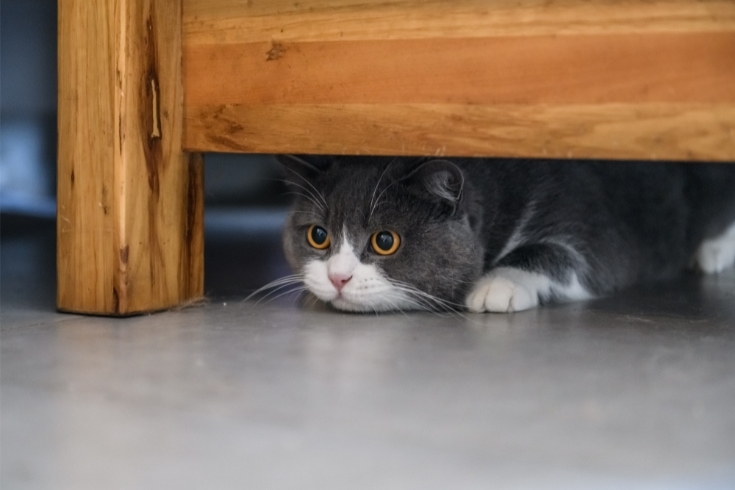
Yes, your cat’s behavior can change with age.
Kittenhood
When your cat is a kitten (up to 6 months old), she will be lively and curious, spending lots of time playing and exploring between napping.
Kittens are more inclined to chase, pounce, and climb and form bonds with other animals and humans more quickly than older cats, which is why this is the best time to socialize your pet.
Adolescence
Your cat enters her teenage phase from 6 months to 2 years. During that time, your pet is typically increasingly independent and loves to explore and roam, testing boundaries, becoming territorial, and sometimes rebellious.
Adulthood
Your cat is considered an adult when she’s between 2 and 10 years old. At that age, cats are typically more settled in their behavior, although still enjoy playtime and interacting with their owners.
Middle Age
A cat is considered middle-aged when she’s between 10 to 12 years old. These cats often slow down and become less active, sometimes suffering age-related health problems, including loss of vision and mobility reduction.
Senior
Once your cat reaches 12 years and older, she’s considered a senior kitty. Senior cats usually exhibit more significant behavioral changes than at other life stages, sleeping more, becoming more vocal, showing signs of cognitive decline or cat dementia, and developing other health conditions.
Why Would A Cat Attack Its Owner?
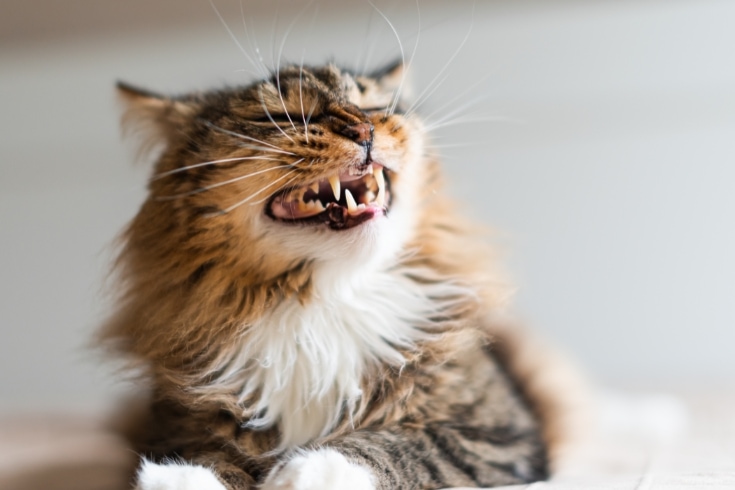
Cats can exhibit aggressive behavior and sometimes attack their owners for various reasons, including the following:
- Fear/Stress: Cats that are stressed or afraid can react aggressively by attacking you, especially if introduced to new animals, people, or surroundings.
- Pain: If your cat is in pain, she might lash out if you try to approach or touch her.
- Territoriality: Feral cats can become aggressive and attack people in defense if they feel their territory and safe space is being invaded.
- Play aggression: If your cat gets overexcited or overstimulated during playtime, she might unintentionally bite or scratch her owner.
- Redirection: If a cat is watching another animal or stimulus outside your window, she might behave aggressively toward you.
- Maternal behavior: A mother cat with kittens might attack you if you approach her simply because she is defending her family and feels they are in danger.
- Poor socialization: A poorly socialized cat might react aggressively toward her owner because she is confused or afraid and doesn’t understand how to behave.
- Punishment: Cats that are repeatedly punished by their owners learn to associate that person with a negative experience and can become defensive when approached by them.
- Medical conditions: Some medical conditions, including neurological disorders and hyperthyroidism, can cause a cat’s behavior to change and become more aggressive toward her owner.
If your cat attacks you, you must seek advice and guidance from your vet or a professional animal behaviorist to determine what’s causing the behavior and how to fix it.
Can You Discipline Cats?
Cats are independent creatures with their own behaviors and instincts that can be difficult to modify and change.
Rather than disciplining your cat, focus on understanding why she behaves the way she does, and provide appropriate positive reinforcement training and enrichment to encourage desirable behaviors instead.
Why Is My Cat Agitated?

Cats can get agitated for many reasons, including the following:
- Health problems: Your cat could be agitated because she is in pain, discomfort, or ill. If your cat’s behavior is unusual or she is showing signs of distress, it’s critical to have her checked over by your vet.
- Environmental changes: Cats generally don’t like change, and alterations in their living space and environment can stress them out and cause agitation.
- Not enough stimulation: If your cat is bored or doesn’t have sufficient outlets for her energy, she could become agitated.
- Overstimulation: Conversely, if your cat is exposed to too much activity or attention, she might become agitated.
- Fear: If your cat is startled or frightened by a loud noise or a perceived threat, she could become anxious and possibly agitated.
- Past experiences: A cat that has been traumatized or abused in the past could be prone to agitation under certain circumstances.
- Medical conditions: Some medical conditions, including cognitive dysfunction in senior cats, can cause behavioral changes, including periods of agitation.
- Hormonal changes: Male unneutered cats can become agitated when confronted by a female in heat, and female cats can react the same way during their heat cycles.
- Hunting instincts: Cats are natural predators and might become agitated and overexcited when they see a small creature such as a mouse, especially if they cannot reach or capture it.
- Poor socialization: A cat that hasn’t been properly socialized with people and other cats during her early years might become agitated when confronted with new social situations.
Why Do Cats Become Mean?
A cat can sometimes become mean for the same reasons given in the questions above about agitation and cat attacks.
Conclusion
I hope you enjoyed our guide to cat behavior problems, their causes, types, and management. If you did, please remember to hit the share button above before you go.
Cat behavior problems refer to any undesirable, abnormal, or problematic actions by a domestic cat. Behavioral problems vary in severity and impact and can affect the cat’s relationship with its owner and family.
Causes of cat behavior problems can include health conditions, stress, poor socialization, environmental changes, and incorrect training. Undesirable behaviors can include excessive vocalization, aggression toward you and other pets, scratching your home furnishings, and forgetting to use the litter box.
Fortunately, most cat behavior problems can be addressed using positive reinforcement, clicker training, sound deterrent, and remote correction. However, if you find yourself struggling to fix your cat’s bad behavior, it’s essential to seek professional advice from your vet or an animal behaviorist.
Does your feline friend misbehave? Tell us about your feisty feline in the comments box below!